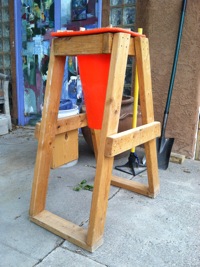
| Techniques Filling bags: Having two people - one holding the bag open, the other filling it with a shovel or a bucket - works, but it's slow, ridiculously messy, and frustrating. If you're working by yourself with a shovel in one hand and a bag in the other, it's next to impossible. You're far better off developing a system and setting up a smooth & efficient production line to keep your bags moving. There are a variety of approaches, which we'll briefly touch on. All of these can be done by one person.
Most bags come with tie strings attached. In the case of building (if the bags are going to be plastered over), you generally don't need to tie them. You can just give the neck a twist, fold it under, and butt this end of the bag securely against the sewn end of the adjoining bag. If you want or need to secure your bags, you can use the ties - though they're often flimsy & a nuisance. We prefer to use zip ties or wire ties. Laying bags: Grab bag by neck with one hand & grab the seam on the bottom of the filled bag with the other hand. Invert the bag, letting the fill run down towards tied-off neck. Shake bag, distributing dirt uniformally. 1.) Fold top of bag under & lay in place (butting this end up against the seam edge of previous bag). 2.) Give bag a good shaking to ensure even distribution of dirt (bag should be roughly rectangular). 3.) Continue laying bags, using tamper every 3-4 laid bags & checking your work with a level. Part of what makes this fun is that this is an organic process. Shaking & sorting & patting your dirtbags is something that comes easy. You'll quickly master an almost intuitive ability to make corrections when irregularities pop up. Once it "feels" right, start tamping and use your levels. If things start getting wanky, you can use your tamper to make corrections - whack a little more here, a little less there, and using it laterally (horizontally) to even up the face of it. Doors & windows: Doors will need to have a frame. You'll prop this in place (use your level!) and then, as each course meets the frame, you'll tamp the bags securely. For additional strength, you can drive nails or screws into the sides of the frame to twist the courses' barbed wire around, or incorporate gringo blocks (see "getting started"). As you work your way up, check the door to make sure the frame isn't askew and causing your door to bind - you don't want to have to undo everything & start again. When the sides of the frame are bagged in, you'll add a load-bearing lintel to the top of the door's frame and then stack & tamp your bags across the top of this. Conventional windows (that is, windows that open) will usually come with a frame. You may want to insert a load bearing sill (wider than the window) where your window will go. This sill, if it projects out far enough, will make a shelf that you'll be glad to have when you move in. Then install & pack your bags around it as described above. Finish up with header on top, and finish your bagging. Windows without a frame need not require a sill or a header, if they're strong enough to sustain the weight of the bags on top. If they're round, you can leave one bag out of your course, insert your window, then pack your bags around it with each successive course. You'll find this easier to do if you only use 1/2-filled bags so you can smush them into shape. More: Barbed wire: As mentioned elsewhere, start using 12" - 14" wire strips between bags if your wall or structure is above 3 feet. We recommend two strips of barbed wire per bag. After laying a bag, firmly twist the bag to "seat" the barbs before moving on. Buttressing: Think of these as reinforcing pillars every 6-10 feet or so along the length of a wall. Don't underestimate the importance of buttressing long, high walls, and don't count on a plaster / stucco overlay to give such a wall the significant structural strength you'll want when the kids are climbing on it. Rule of thumb for buttresses is 6" perpendicular to wall for every foot of wall height. Burlap bags: Using these bags requires working quickly, under dry conditions, and then plastering them as soon as possible. You should build a stem wall (bags filled with gravel, etc.) to raise them above ground level to prevent moisture from wicking up. Leveling: We can't emphasize this enough. Frequently check your work in all 3 dimensions. Earthbags  are something you don't want to have to take apart &
reassemble (especially if you're using barbed wire), so get
it right the first time. Is your course running straight
(end to end), or starting to drift? Is the course the same
height at both ends? Are the bags starting to slant inward
(towards you) or outward (away from you)?
are something you don't want to have to take apart &
reassemble (especially if you're using barbed wire), so get
it right the first time. Is your course running straight
(end to end), or starting to drift? Is the course the same
height at both ends? Are the bags starting to slant inward
(towards you) or outward (away from you)? Check the wall itself periodically with a beam level to see if it's starting to cant towards or away from you. If you stay on top of it, you can self-correct with the next bag. We talk about this a little more on the getting started page. Of course, if you want undulations or sinuousity, that's something different. The point is to pay attention & make sure that things are going as you intended. Bigger projects: Some people spread the work on bigger structures over a year or two, which also allows spreading the cost out. You should consider it mandatory to either tarp & secure your work as you go along, or slap some base plaster on your bags to protect them. Because our New Mexico sun & altitude are so hard on polypropylene bags, they will start to disintegrate after a few months. Strong winds carry abrasive sand as well, and can do a number on your hard work. Burlap bags are equally prone to weather, as well as dampness, insects, soil bacteria, and critters. So, again, keep your work covered. copyright © 2009-2023 New Mexico Dirtbags |
